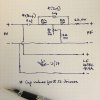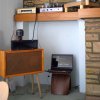Thanks Joe… I’ve seen your various autoformer hacks, but can you point to a “real” auto former whether vintage or new or just comment on what you’ve been using?It is good advice to put the 32 as close to the woofer as possible, but be careful to make sure that the driver clears the woofer! An 802 on that bent horn makes for rather narrow clearance behind the baffle. You have been warned! Measure!
The thing to remember about an autoformer with a resistor across the primary is that it gives you a nice solid termination for the filter network. You calculate the values according to this nice fixed resistor instead of a nominal impedance value which varies with frequency. This is not a "reflected" load. it is a directly connected frequency insensitive load.
Then, the reflected, i.e. transformed, impedance variations of the driver are stepped up to high values by the transformer and have less effect on the filter since they don't change the value of that resistor so much by appearing in parallel with it.
You can basically size the primary resistor to pick the cap values you want to use! High resistor = smaller value caps.
The difference between this and an L-pad is that only one resistor is needed whereas an L Pad or pot has multiple resistors in a voltage divider configuration. An L pad presents a constant resistance to the input whereas a pot does not.
No attenuator is needed here since the autoformer is an attenuator, operating after the filter has done its job.
Werner's crossover looks pretty good, although not exactly free. I don't see the need for the variable termination except perhaps for voicing experiments, but otherwise nice job.
I'd also try with and without any LF zobel. I almost always like things better without.
JE reminded me and It might be helpful to explain one difference between the 15” woofer variants and the 414’s is that the 414’s are running full out up top.












